Mar-27-18
 | | KEG: This game between two tail-enders (Didier was 0-12 going into this game) in the Paris 1900 tournament has many exquisite tactics points of interest. Mason gets in trouble when he pursues a bad plan and winds up in an endgame in which he was probably lost by move 20, but then fights his way back into the contest only to blunder back into a series of positions in which Didier has a number of often-problem like winning chances. Once again (as in many of his prior games at Paris 1900--most notably his game against Pillsbury) Didier missed his chances and wound up with a draw that netted him zero points since in this tournament draws were replayed and Mason made short work of Didier in the replay the following day. 1. e4 e5
2. Nf3 Nc6
3. Bb5 a6
4. Ba4 Nf6
5. 0-0 Nxe4
6. d4 b5
7. Bb3 d5
8. dxe5 Be6
9. c3 Be7
Both the text and 9...Bc5 are reasonable lines in this variation of the Open Ruy Lopez. 10. Re1
10. Nbd2 and 10. Be3 are more usual here, but the text is certainly OK. 10... 0-0
11. Nd4
The position now was:

click for larger view11... NxN
Rosenthal in the Tournament Book claimed that 11...Nxe5 would have lost to 12. f3. But this analysis is superficial. After 11...Nxe5 12. f3 Black has two playable lines. A) The main (and probably best) line is 12...Bh4 after which chances are about even after 13. Re2 (if 13. g3 c5 14. NxB fxN 15. f4 [if 15. fxN Bg5 and Black--though temporarily down a piece, has if anything the better chances] Nc4 16. gxB Qxh4 and Black, though down a piece, has excellent chances) 13...Nf2 (or 13...Bf2+). B) The wild line: 12...c5 13. fxN (or 13. NxB fxN 14. Bd6 and Black's attacking chances against White's undeveloped position gives him approximately equal chances despite the lost piece) 13...Bd6 14. Nf5 BxN 15. exB c4 16. Bc2 Re8 17. Re2 Bc5+ 18. Be3 BxB+ 19. Re2 Qb6 and Black though once again still down a piece has dangerous counterplay. Perhaps Black's best play here, despite the thrilling possibilities above after 11...Nxe5, is 11...Bh4 Anyway, let's get back to the actual game:
12. cxN Bb4
12...Bh4 was probably sounder, but the text is not unreasonable. 13. Re2
Rosenthal claims that 13. Bd2 was better, but after 13...NxB 14. BxB g6 (rather than Rosenthal's 14...f6) and Black has at least equality. Didier's 13. Re2 was best. The position was now:
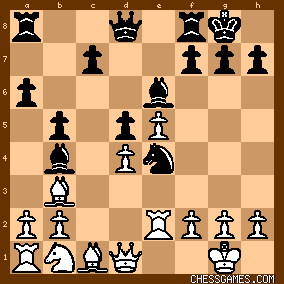
click for larger view13... Qh4?!
The beginning of a bad plan by Mason that gets him in trouble. The King-side attack he launches with this move has no real prospects. Better were 13...c6 or 13...Bf5. The text itself is not so bad, but Mason is pursuing a misguided plan as we will see. 14. f3
14. a3 was also good.
14... Ng5
15. Rf2
Rosenthal was correct that 15. Nc3 would have better for White. 15. Be3 or 15. a3 would also have been superior to the text. 15... f6
16. Nc3 BxN
Beginning with the text Mason works his way into a lost endgame. 16...c6 was much better. 17. bxB fxe5
18. dxe5 c6
The pretty 18...Nc4! was perhaps the only way to hold the balance. 19. Qd4 QxQ
Mason, as always, relied on his endgame prowess, but this is nonetheless a bad move and lands him in an endgame that is probably lost. He should have played 19...Qh5 20. cxQ
This left:

click for larger viewMaterial is even, but Black's weak pawn at c6 should probably have spelled defeat. But from here, as I will discuss in my next post on this game, Mason fought back and achieved a defensible position--only to land in even bigger trouble beginning on his 28th move. |
|
Mar-27-18
 | | KEG: Post II
Mason was in trouble after 20. cxQ, but from here--at least for a while--he displayed is endgame prowess, outplayed Didier, and fought his way back into the contest. 20... Nf7
20...h6 was a good alternative.
21. Ba3
21...h3 was better.
21... Rfc8
22. h3
Having played 21. Ba3, Didier should here have jumped at the opportunity to play 22. Rc1 and attack Black's weak point (i.e., the pawn on c6). 22... a5!
All of a sudden, Mason has developed counterplay. 23. Bc5
Now, thanks to Didier's dithering, the threat to the c6 pawn is at least postponed. Mason skillfully makes use of the time Didier has lost. 23... Nd8
24. a4
Having messed up his Queen-side chances, Didier here might have begun a King-side assault with 24. g4. Alternatively, he could have prepared his attack on c6 beginning with 24. Rc1. 24... Nb7
24...b4 was another possibility.
25. Rc1 h5
Anticipating g4 from White.
26. f4 g6
The position was now:
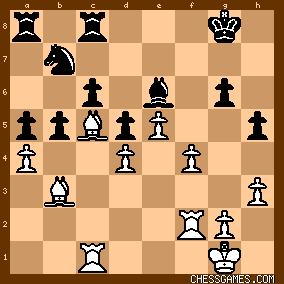
click for larger viewMason has unquestionably made progress, but Didier still has the better of the context. With 27. g4, Didier might have given Mason trouble after 27...hxg4 28. hxg4 bxa4 29. Bxa4 Bxg4 30. Be7 Nd8 31. BxN RxB 32. Rc5 with strong pressure. But instead Didier played: 27. Be7 Kf7!
Mason's only saving move here, but a good one.
28. Bg5 c5!
With this strong move, Mason is back in the game, but from here he lost his bearings. 29. axb5
The position was now:
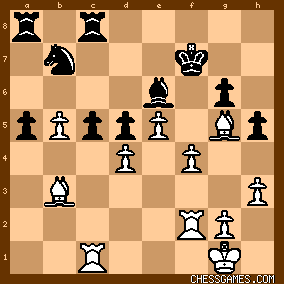
click for larger view29... cxd4?
This reflex capture undoes all the fine work Mason had performed to get back into this game. He overlooked the fine intermediate move 29...a4! 30. Bd1 cxd4. Now, he is probably lost again. 30. Rfc2!
Well played by Didier, who now assumes control of the crucial c-file. The position was now: 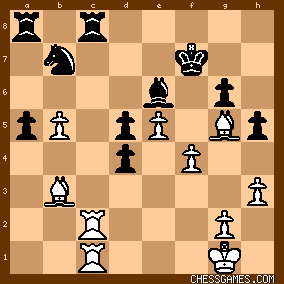
click for larger viewDoes Mason have any real defense at this point? His only hope, as I will try to show on my next post, was to try a desperate sacrifice--an opportunity Mason missed. Mason's failure at this point should have cost him the game. |
|
Mar-28-18
 | | KEG: Post III
Mason's 29...cxd4 left him in bad shape. After Didier's 30. Rfc2! it appeared that Didier was about to control the board. Mason's reply essentially gave up the ghost: 30... RxR?
This gives Didier a free run and the game should have been a clear win for White from this point. Did Mason have any alternative. I think he did. While I'm not sure it would have been sufficient to save the game (which Mason's actual move only accomplished because of very poor play from Didier), Mason here could and should have tried the move I would bet Tigran Petrosian would have played in a heartbeat: an exchange sacrifice with 30...Rc4! Had Didier then accepted the "gift" with 31. BxR play would have gotten interesting after 31...dxB. Now, with Black holding two passed pawns, White would probably have to return the exchange by playing 32. Rxc4 BxR 33. RxB leaving Didier up a pawn but facing a variety of threats...e.g., 33...a4 34. Rc7+ Ke6 45. Be7 Nd8 46. b6 Rb8 This is still probably a win for White, but it was far better than what Mason faced with his actual move. 31. RxR a4
32. Rc7+ Kf8?
He should have eliminated checking variations with White's Bishop by putting his King on a light square with 32...Kg8. 33. Ba2!
The text by Didier was clearly better than 33. Bc2, but Rosenthal's claim in the Tournament Book that 33. Bc2 would have lost is nonsense: If 33. Bc2 a3 White still wins easily with 34. Be7+ [possible because of Mason's poor 32...Kf8] Kg8 35. Bxa3 RxB 36. RxB 37. RxN (or even more spectacularly with 37. Bxg6!!). In the above line, Rosenthal only considers the inferior 34. RxN? a2, but even then Black gets only a draw with 35. Bxg6 a1(Q) + 36. Kh2 Qc3 37. Bh6+ Kg8 and White has a perpetual check beginning with 38. Rg7+ Back to the actual game after 33. Ba2.
33... Na5
The position was now:
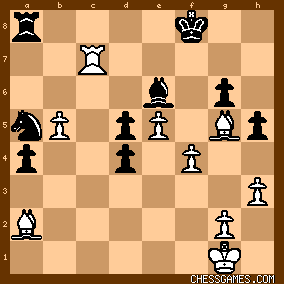
click for larger viewDidier had a clear road to victory now with 34. b6. Even better would have been 34. Bb1 Bf5 35. BxB gxB 36. b6 (or 34...a3 35. b6 d3 36. Ra7). But Didier played the inferior:
34. g4?
Now Mason, though still probably lost, could have made a fight of it with 34...Nc4. But instead, he played: 34... hxg4
35. hxg4 Nc4
As Rosenthal correctly points out in the Tournament Book, 35...d3 loses to 36. f5 gxf5 (36...Rc8 is no better) 37. gxf5 Bxf5 38. Bxd5. After 35...Nc4 the position was:
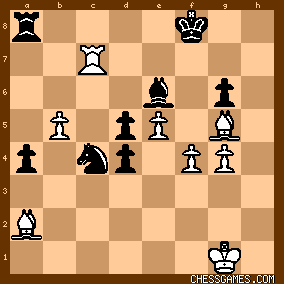
click for larger viewDidier now wins with 36. Bh6+. Instead, he played: 36. b6
This does not blow the win, but it makes life tougher for White. 36... d3!
36...Nxb6 loses, as pointed out by Rosenthal in the Tournament Book, to 37. Rc6! winning a piece and the game. After Mason's careful 36...d3!, the position was: 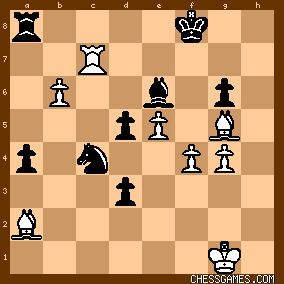
click for larger viewAn interesting position to say the least, but one Didier should surely have won. From this point, however, play became extremely ragged and Mason escaped with a draw only after serious mistakes by both sides as I will attempt to cover in my next post on this game. |
|
Mar-28-18
 | | KEG: Post IV
After 36...d3, Didier had winning lines beginning with either 37. Be7+ or 37. b7. But Didier was on a separate wavelength and pursued a plan that let Mason back in the game: 37. f5?
Now, Mason is back in the game.
37... gxf5
38. b7
One move too late!
38... Rb8
39. gxf5 Bxf5
The position was now:
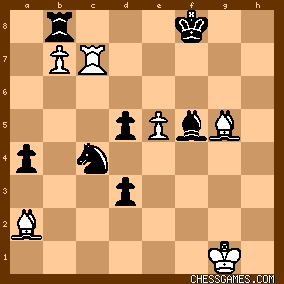
click for larger viewAs Rosenthal notes in the Tournament Book, White at best gets a draw after 40. BxN dxB 41. Rxc4 Rxb7 42. Rxa4. Indeed, after 42...Bb5, any remaining chances lie with Black. But here, Didier found the only move to give him any winning chances: 40. Kf2!
Mason had a few ways of handling the position, namely 40...Ke8 or 40...a3. But Mason apparently thought he now had winning opportunities and erred badly with: 40... d2?
Didier immediately pounced on this mistake:
41. Bxd2 NxB
42. Bxd5
This left:

click for larger viewWhite is temporarily a piece down, but Black's f5 Bishop is in obvious jeopardy, and the b7 pawn is now defended by the d5 Bishop. Black is lost. The only even temporary defense for Black is to play 42...Nb3 and try to bring the Knight to the defense after 43. Rf7+ Ke8 44. RxB Nc5. This would leave: 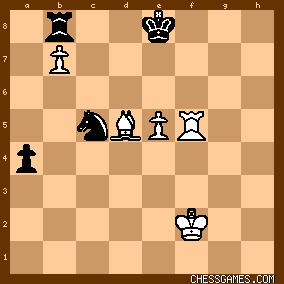
click for larger viewWhite could here play 45. Rh5 and ultimately end up in a Rook and Bishop against Rook endgame, e.g., 45. Rh5 Kd8 46. Ke3 Nxb7 47. Kd4 Na5 48. Kc5 Nb7+ 49. Kc6 Na5+ 50. Kd6 Rb6+ 51. Kc5 Rg6 52. Rh8+ Ke7 53. Rh7+ Kf8 54. e6 Nb3+ 55. Kd6 Nd4 56. Rf7+ Ke8 57. Ke5 Rg4 58. Ra7 Nxe6 59. BxN Rb4 60. Kf6 and Black's a-pawn will ultimately fall leaving Rook and Bishop versus Rook ending. Thus, 42...Nb3 was not a great option, but it was far better than Mason's actual choice: 42... a3?
The position was now:

click for larger viewDidier now had a clear road to victory, but missed this final chance, as I will discuss in my next and final post on this game. |
|
Mar-29-18
 | | KEG: Post V
In the position in which I ended my last post (i.e., after 42...a3), Rosenthal in the Tournament Book examined several possibilities and concluded that White could not win. For example: After 43. Rf7+, Black is indeed fine after 43...Ke8 44. RxB Rxb7! since 45. BxR only draws after 45...a2 46. Bc6+ Ke7 47. Rf7+! RxR 48. Bd5+ 43. Ke2 is better, but also insufficient to win after 43...Ne4 44. Ke3 (much better than 44. BxN a2 45. Rc1 [and not Rosenthal's disastrous 45. BxB?? a1(Q) 46. Rc8+ Ke7 47. RxR Qxe5+ and Black wins] 45...a1(Q) 46. RxQ BxB 47. Ra8 RxR 48. baR(Q) + BxQ But there was a winning line here for Didier that Rosenthal completely ignores: 43. Ke3! Now, the Knight must move--and any move is fatal. Meanwhile, the d5 Bishop keeps the Black a-pawn from advancing and the terrible threat of the b-pawn remains. In other words, White wins easily with 43. Ke3! But instead, Didier played: 43. e6?
This left:
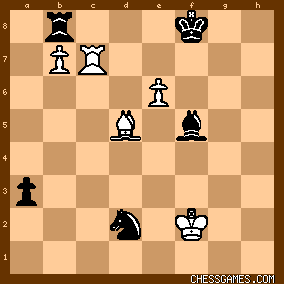
click for larger viewMason now had an immediate draw with 43...Bxe6 since Black then draws easily after 44. BxB Ne4+ 45. Kf3 Nd6 46. Bd5 Nxb7! But Mason kept things momentarily interesting by playing: 43... Ne4+
The position was now:

click for larger viewDidier could have still tried 44. BxN Bxe6! (Black could here go wrong with 44...BxB 45. e7+ and wins or 44...a2 45. e7+) but now a draw would be in sight after 45. Bd5 BxB 46. Rc8+ Kg7 47. RxR a2 48. Ra8 Bxb7 49. Rxa2 leaving a Rook versus Bishop ending. Didier's actual move, however, left a bare draw with no real chance for Mason to go wrong: 44. Ke3 Bxe6
45. BxB Nd6
The players here agreed to a draw:
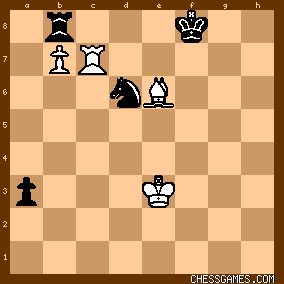
click for larger viewWhat a series of missed opportunities by Didier, who lost the replay (with Mason as White) the next day and found himself still in the cellar with a score of 0-13. |
|
|
|
|





